
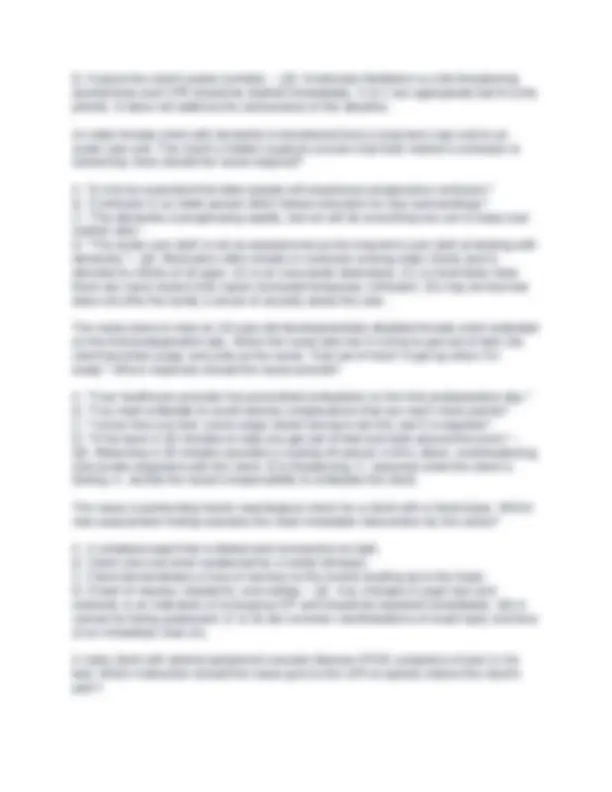
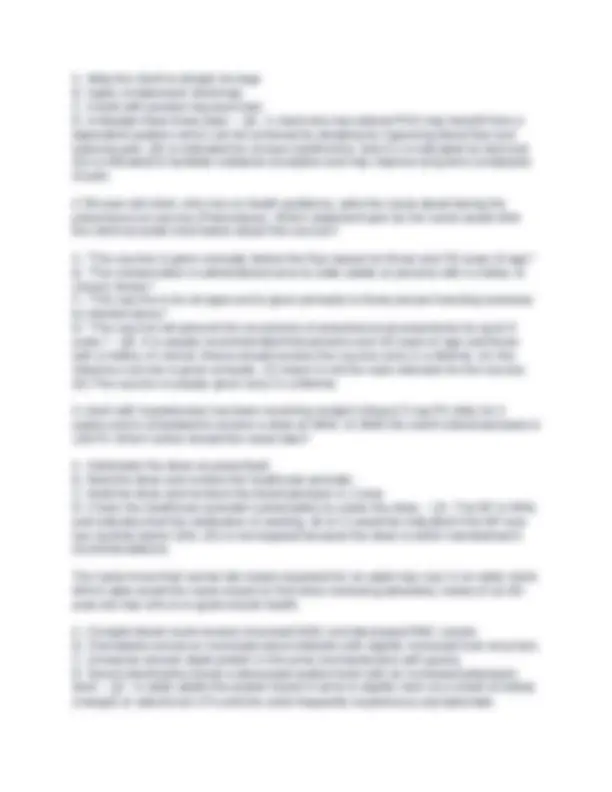
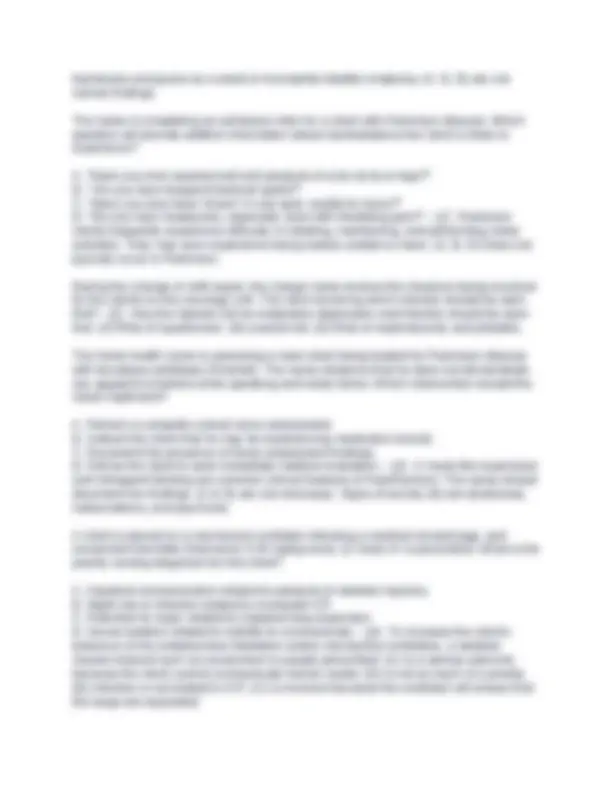
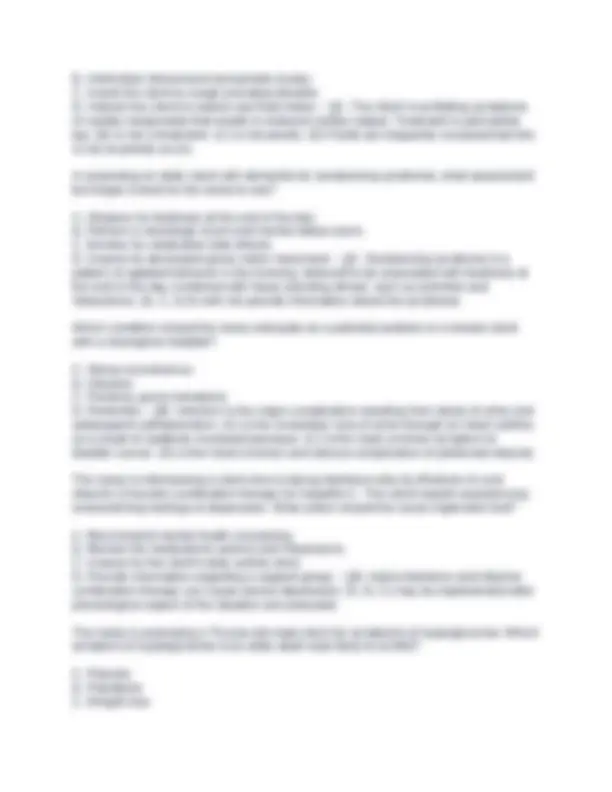
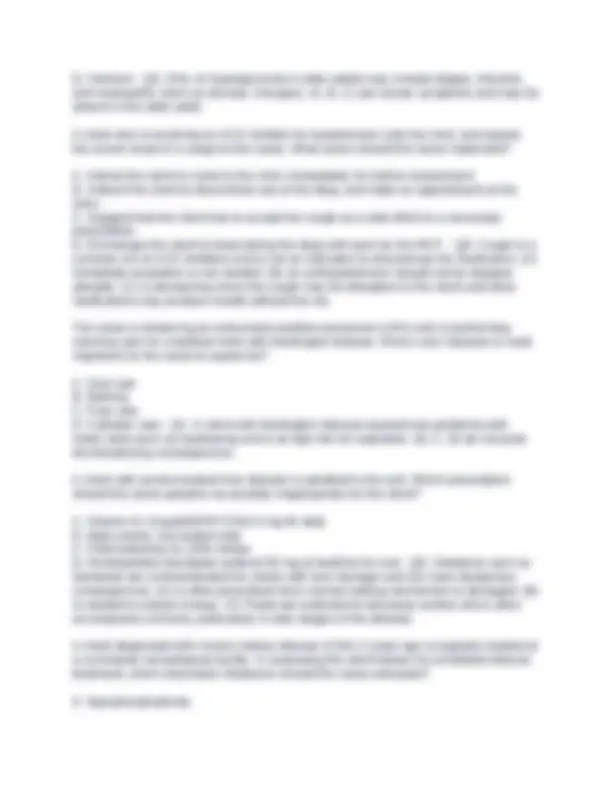
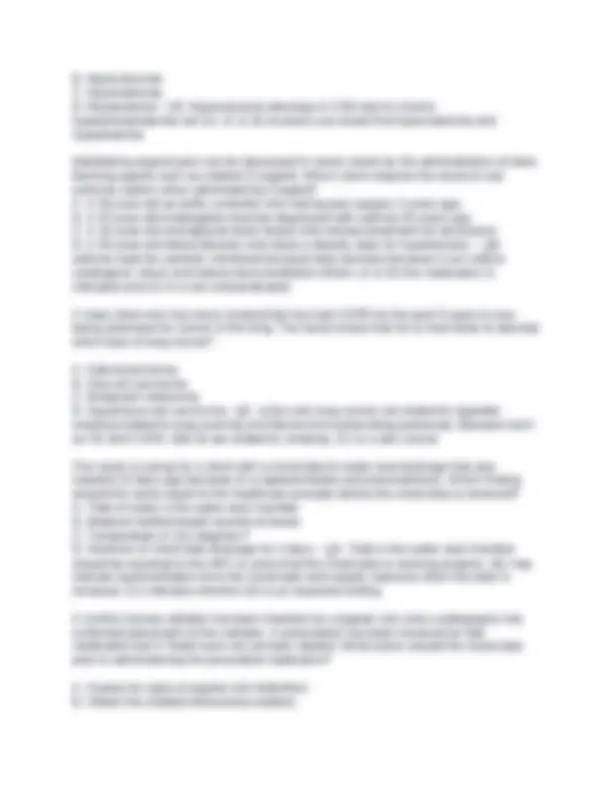
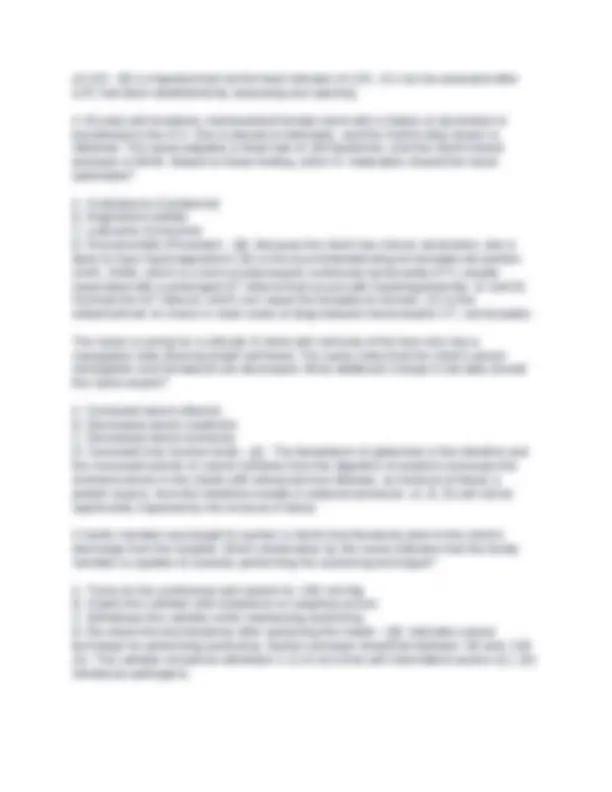
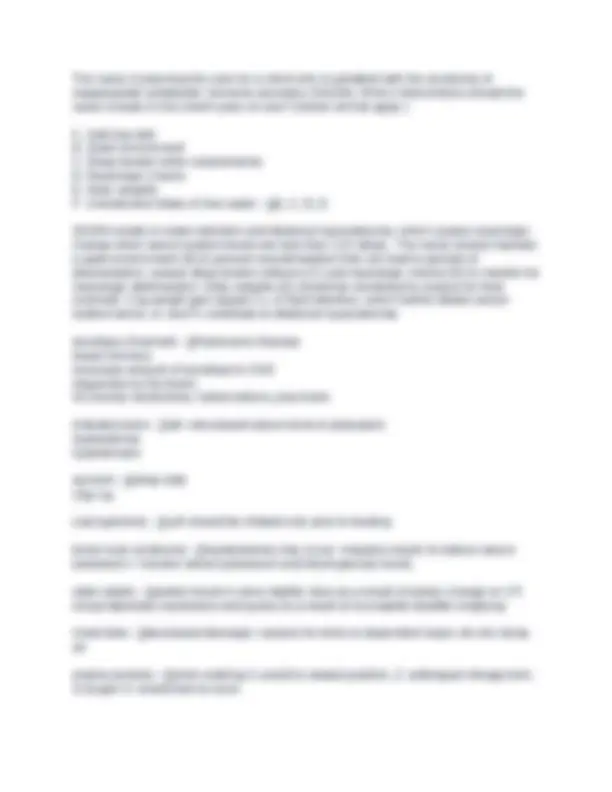
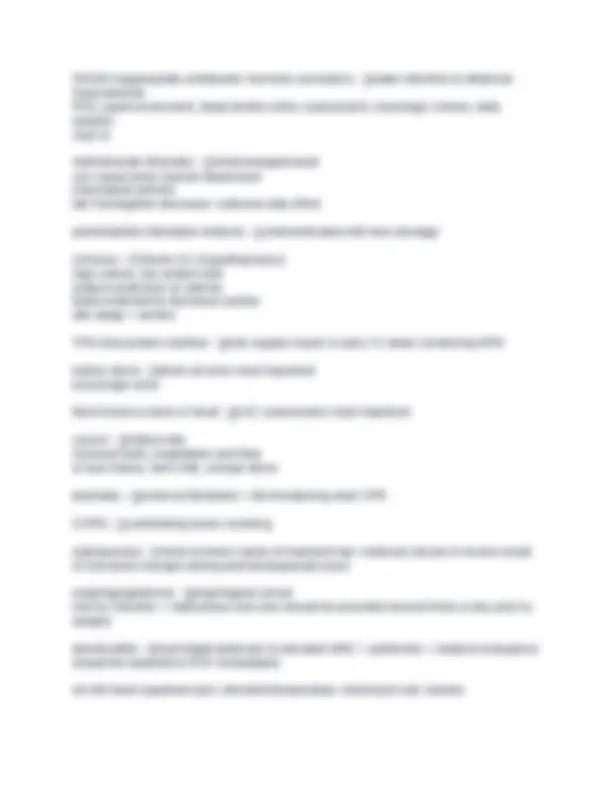
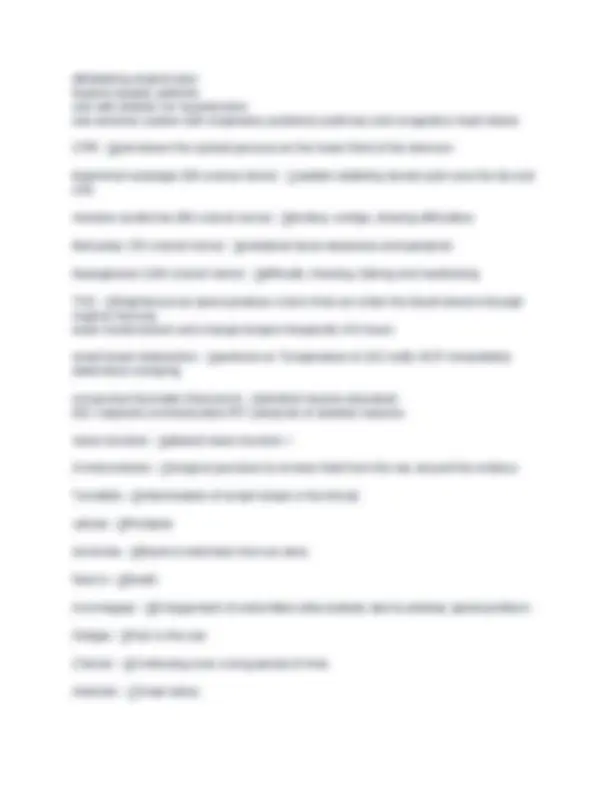
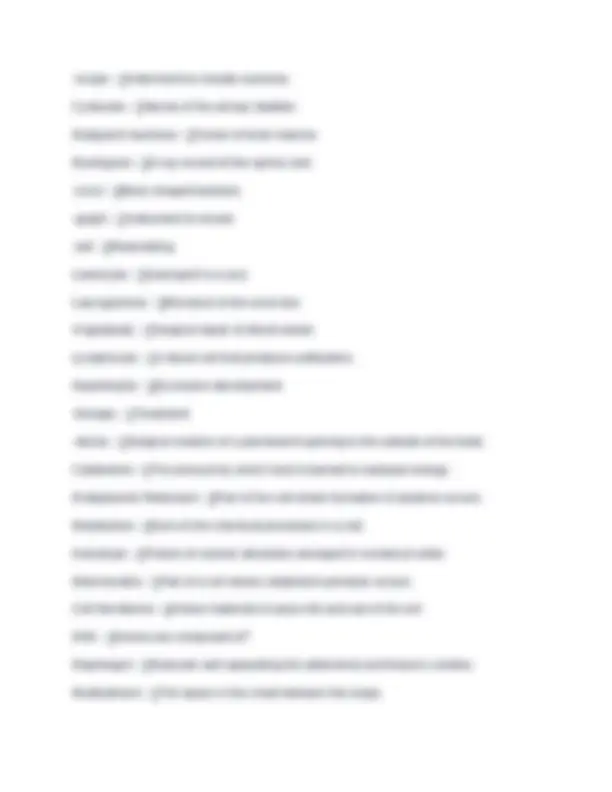
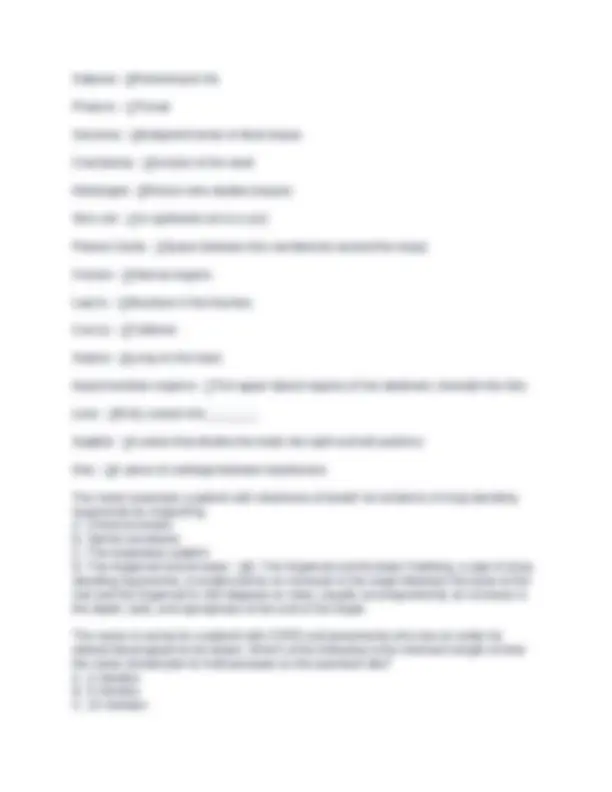
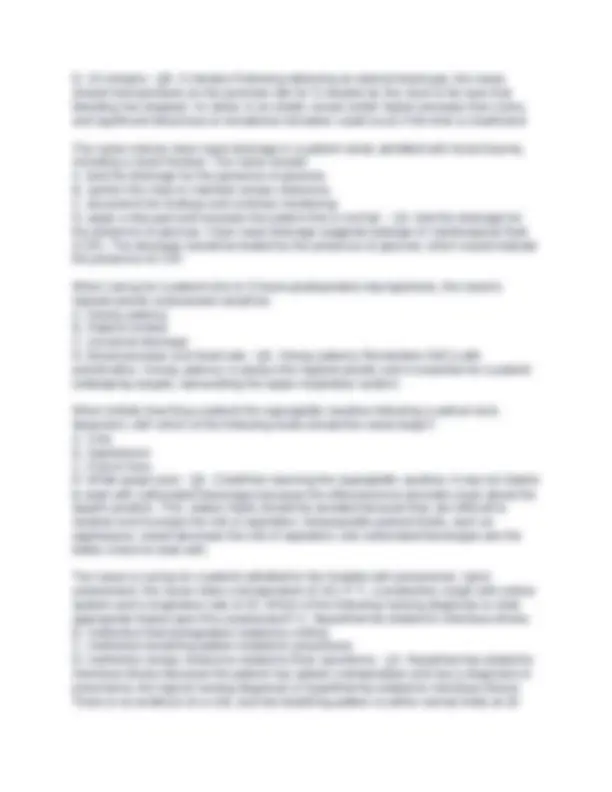
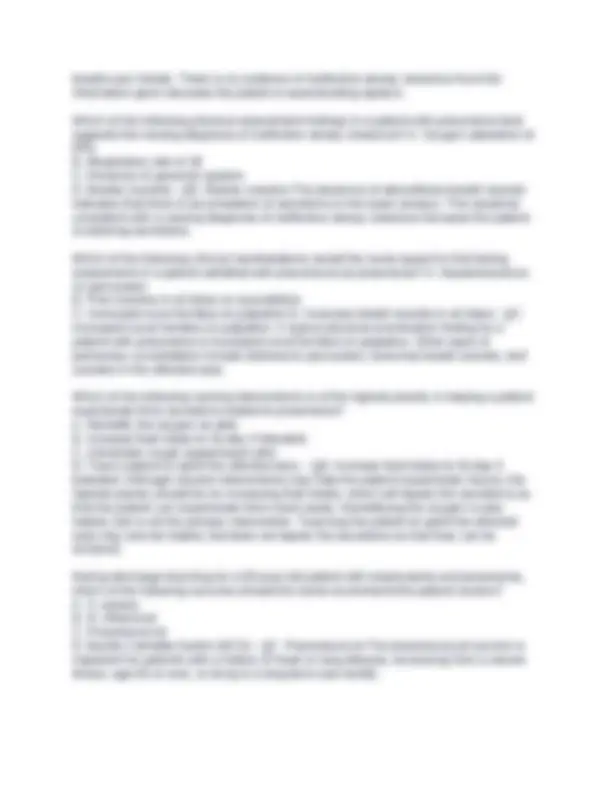
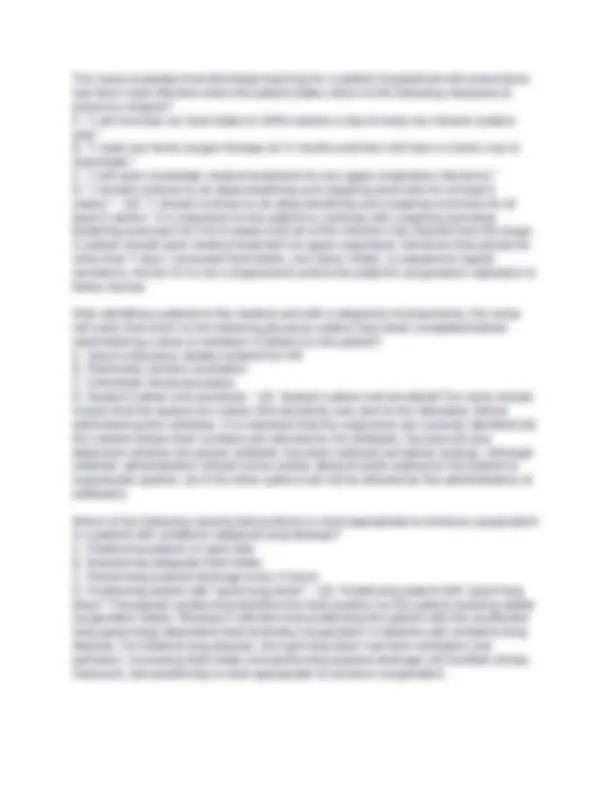
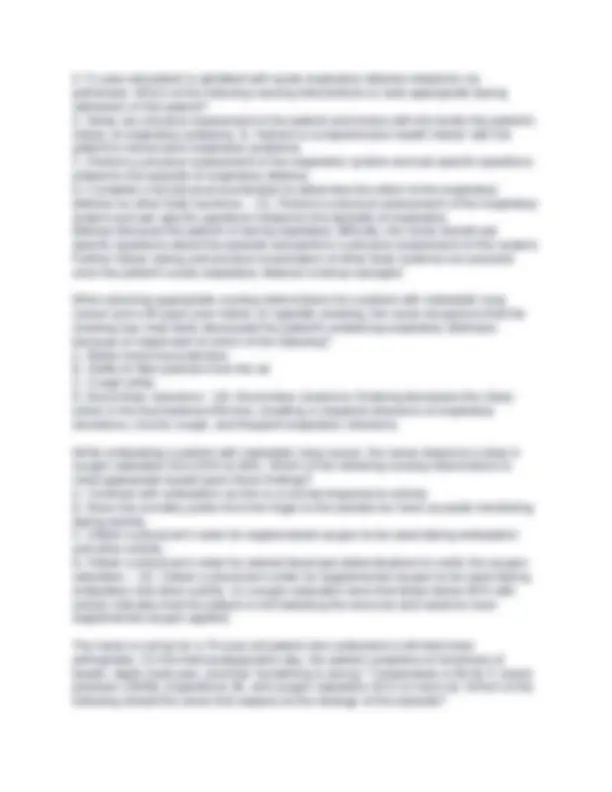
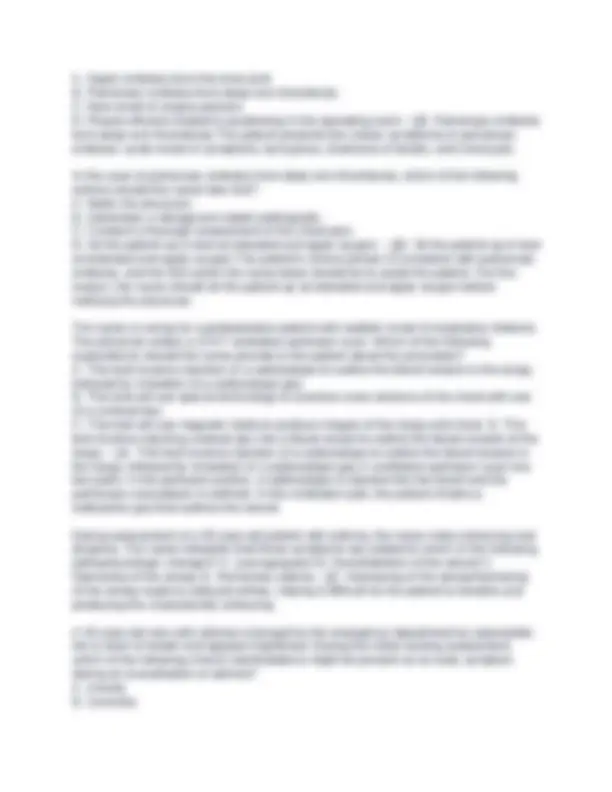
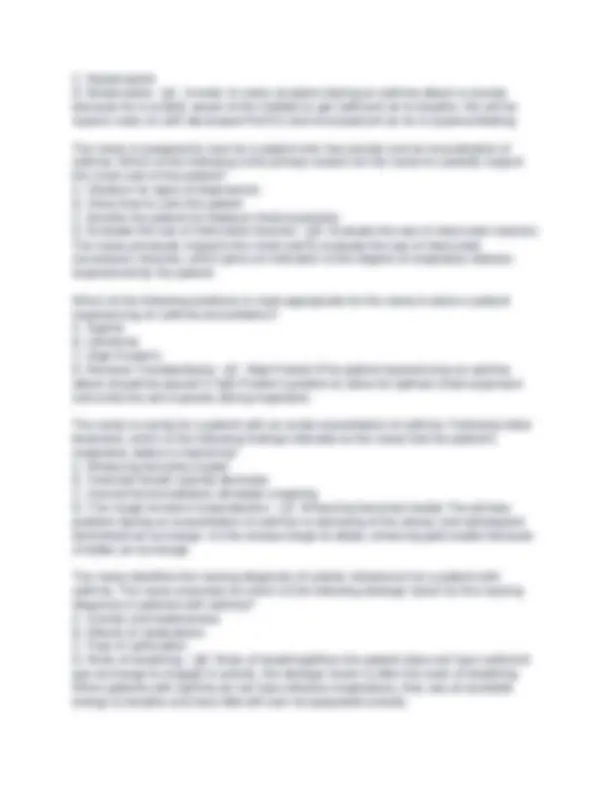
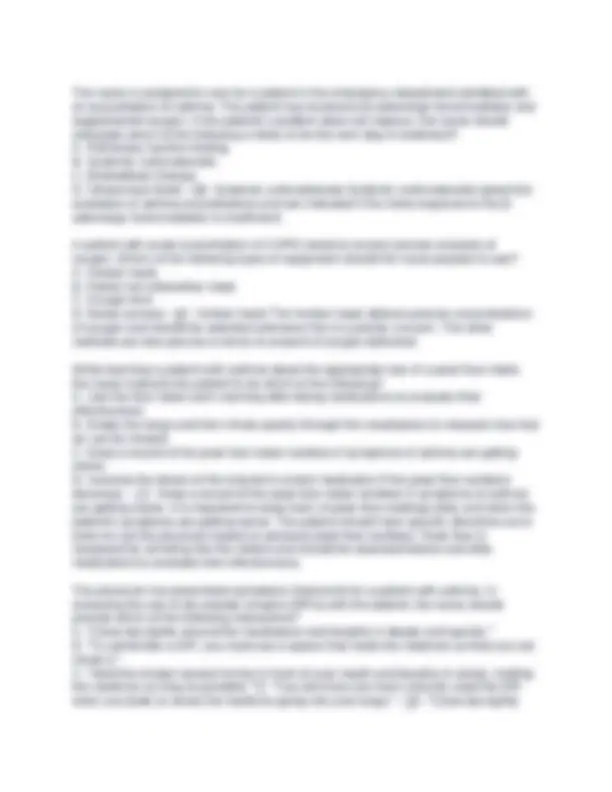
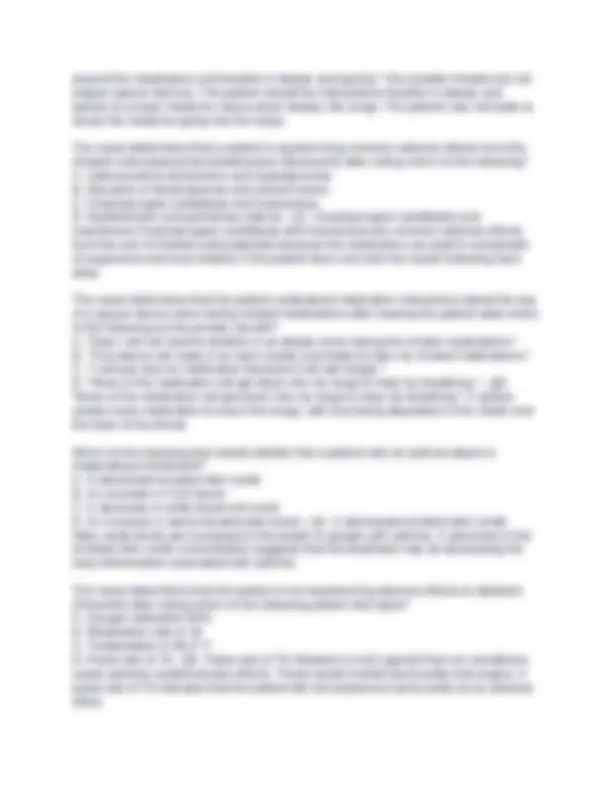
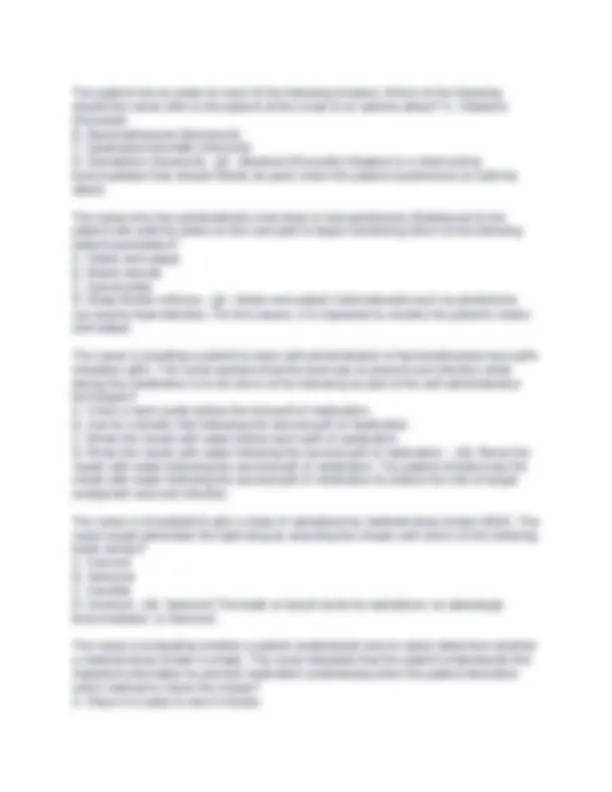
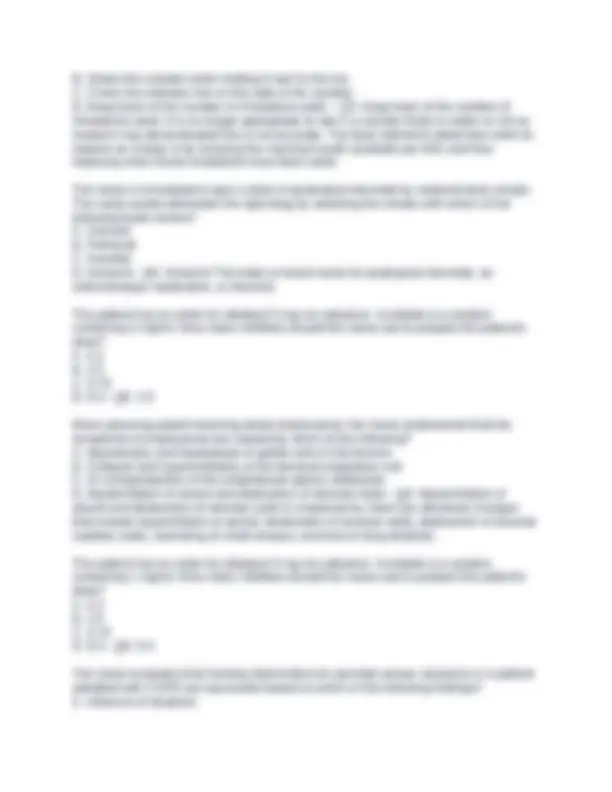
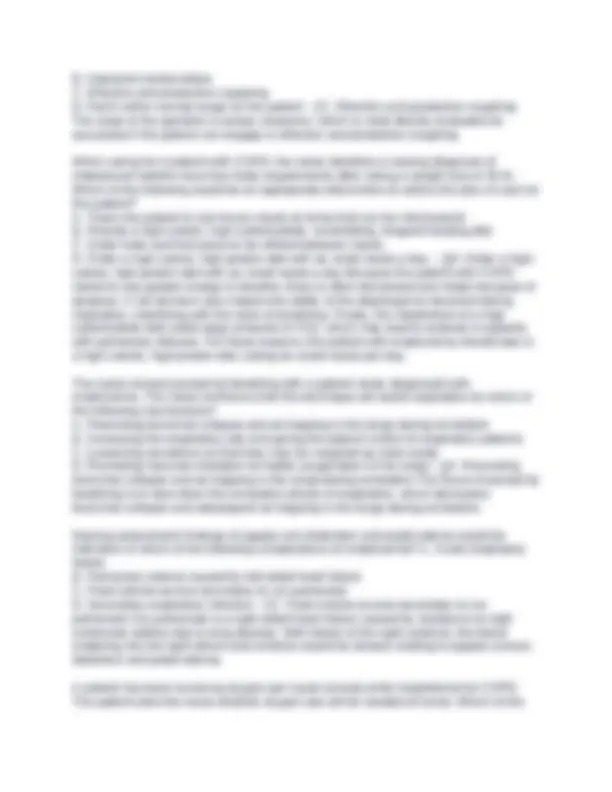
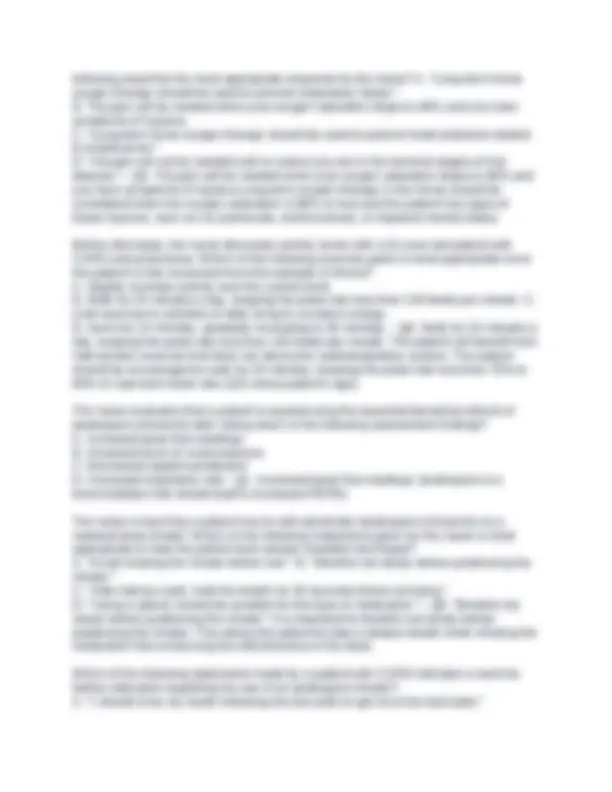
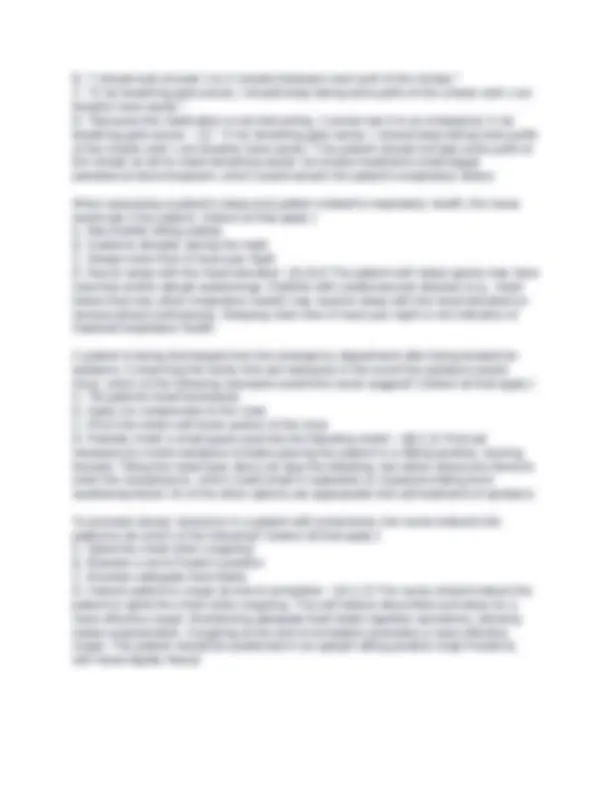
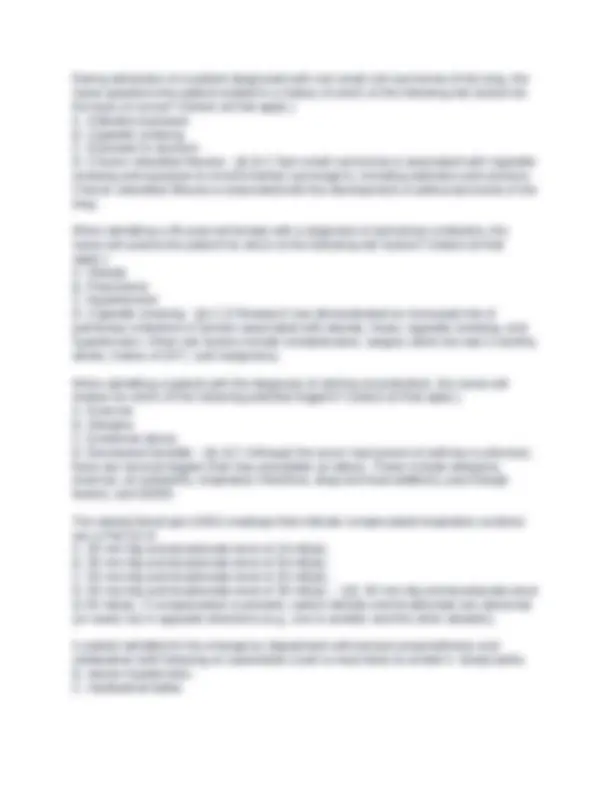
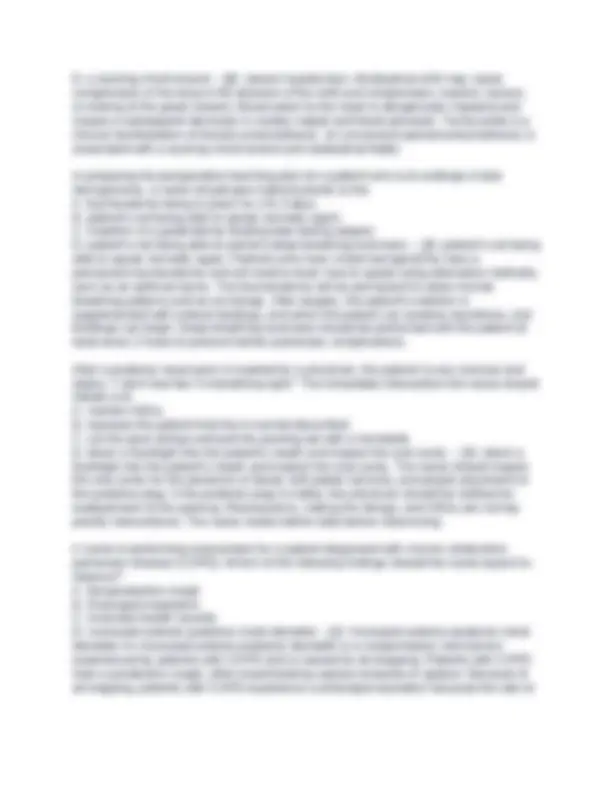
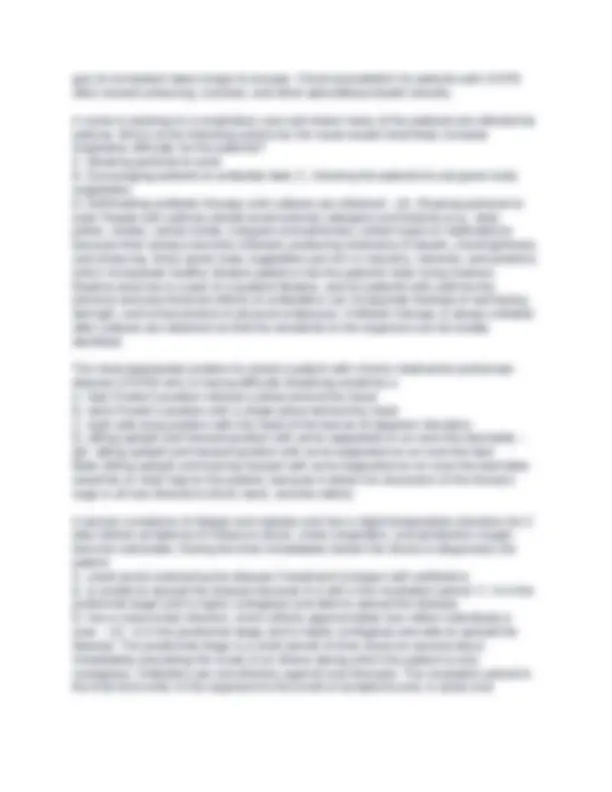
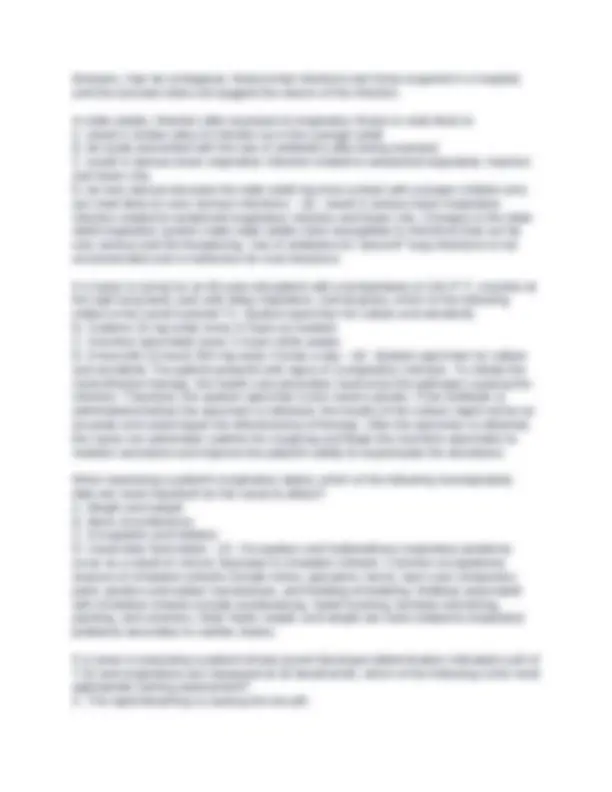
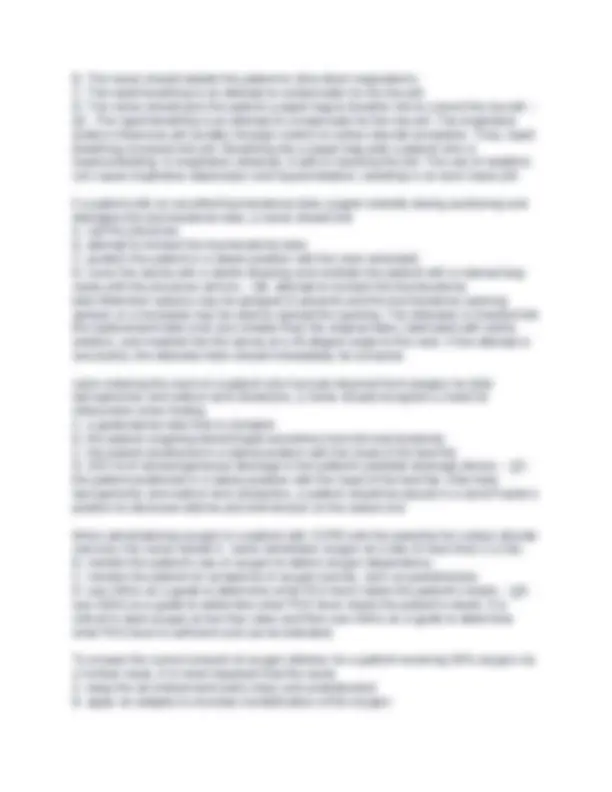
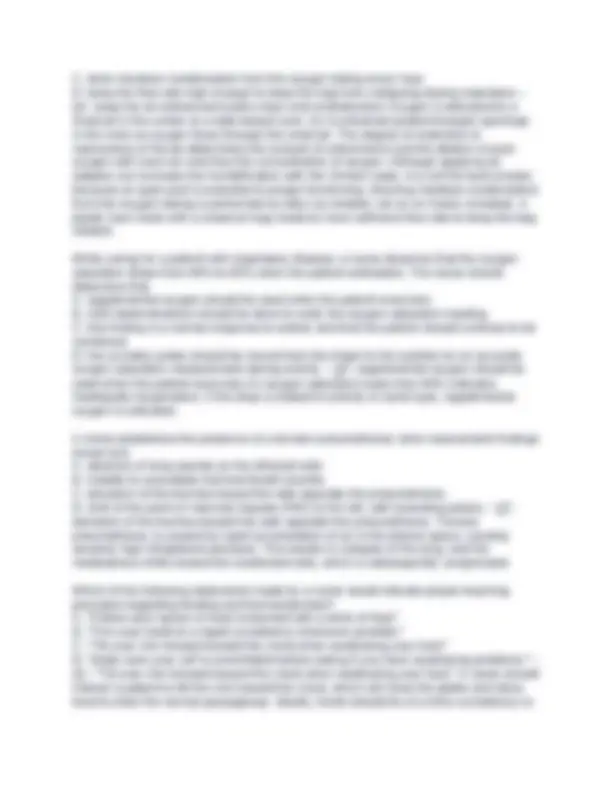
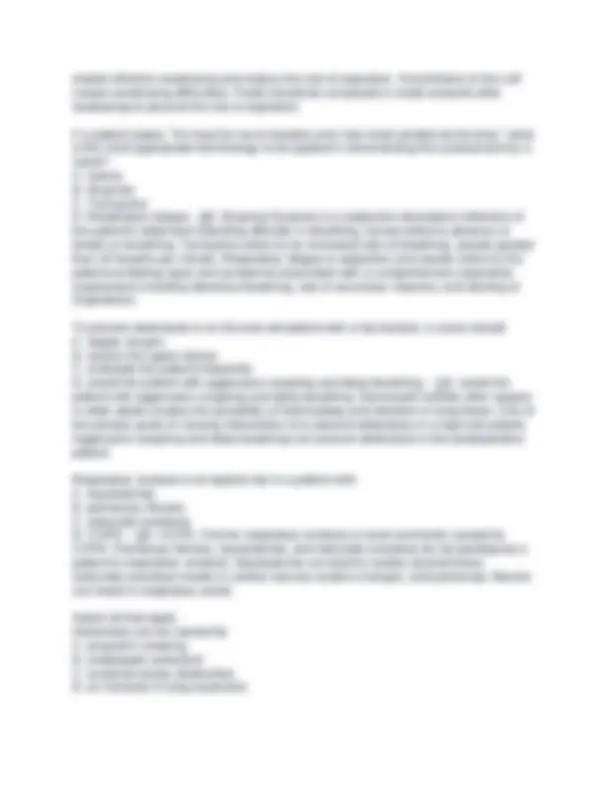
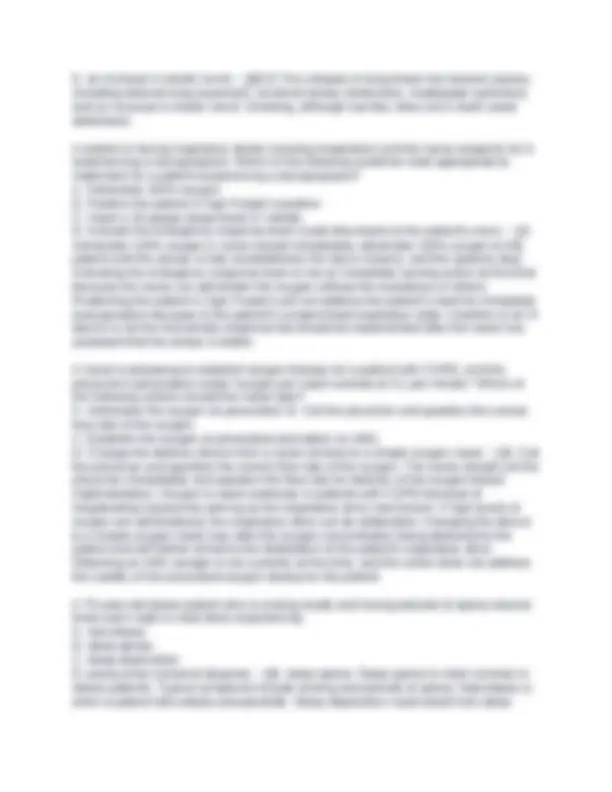
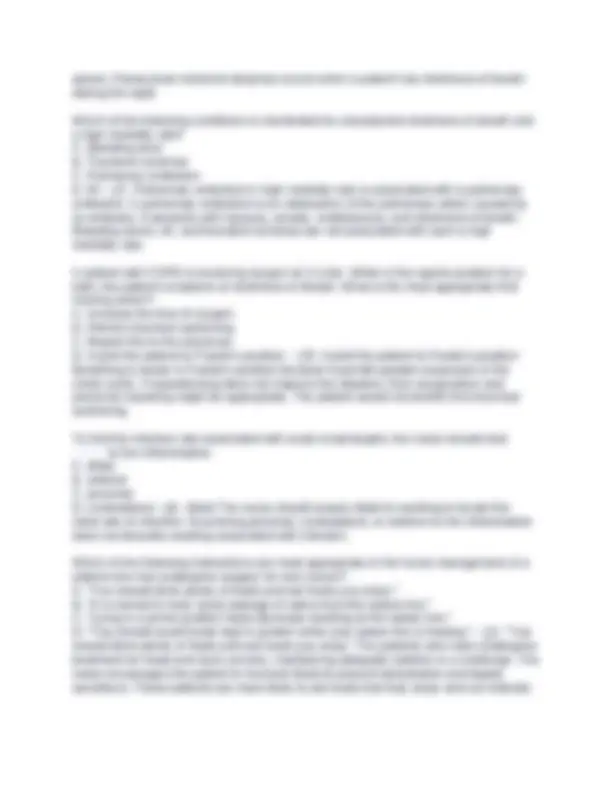
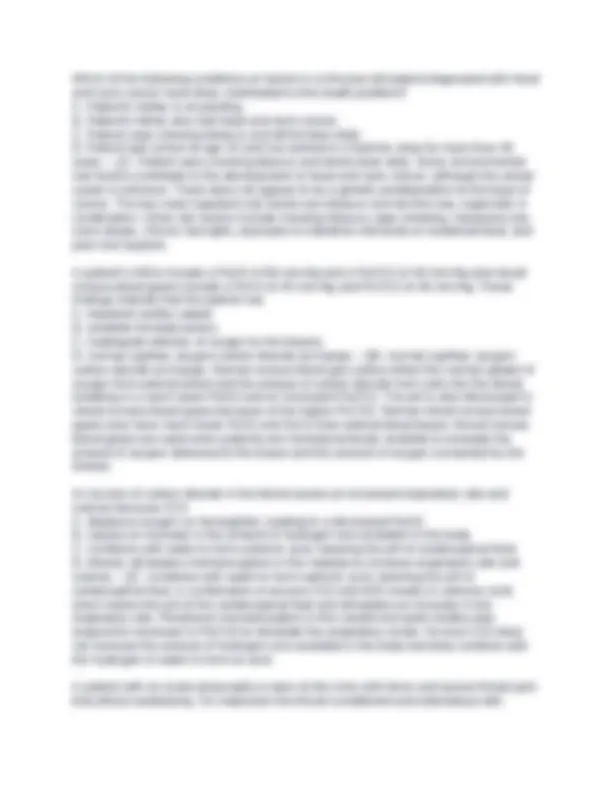
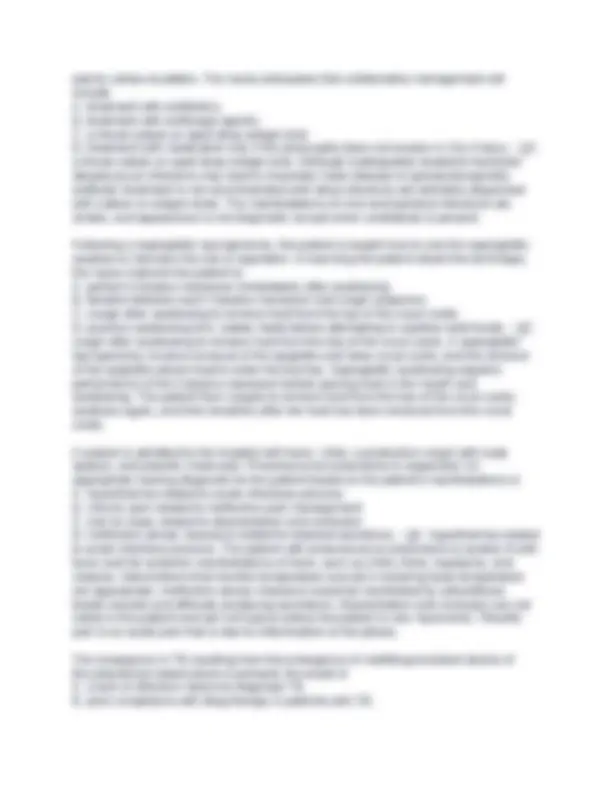
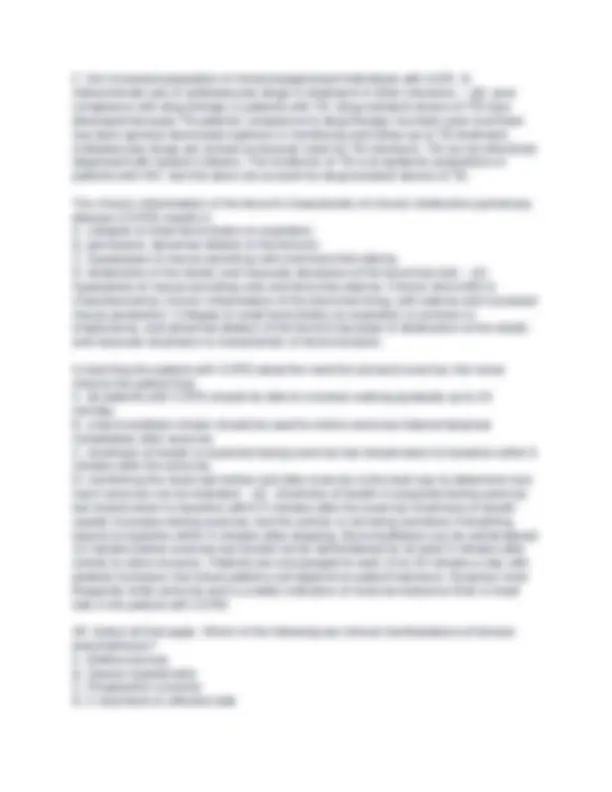
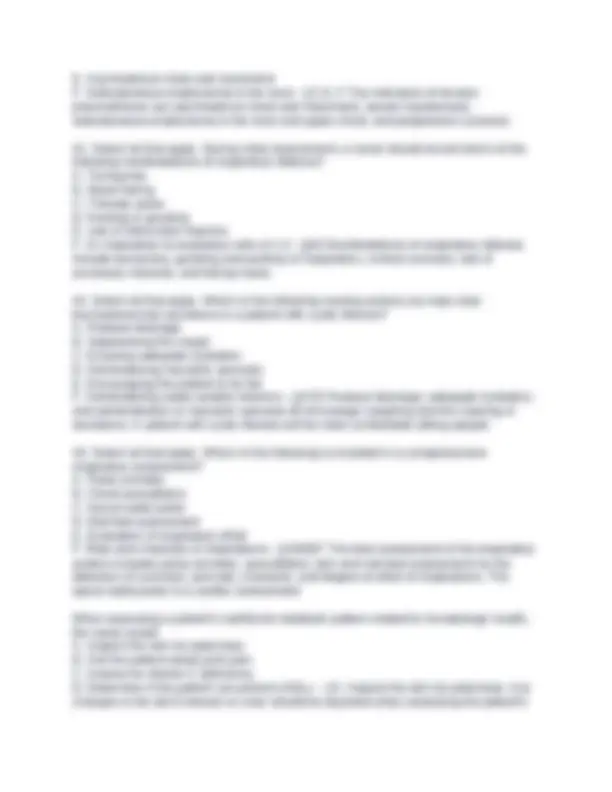
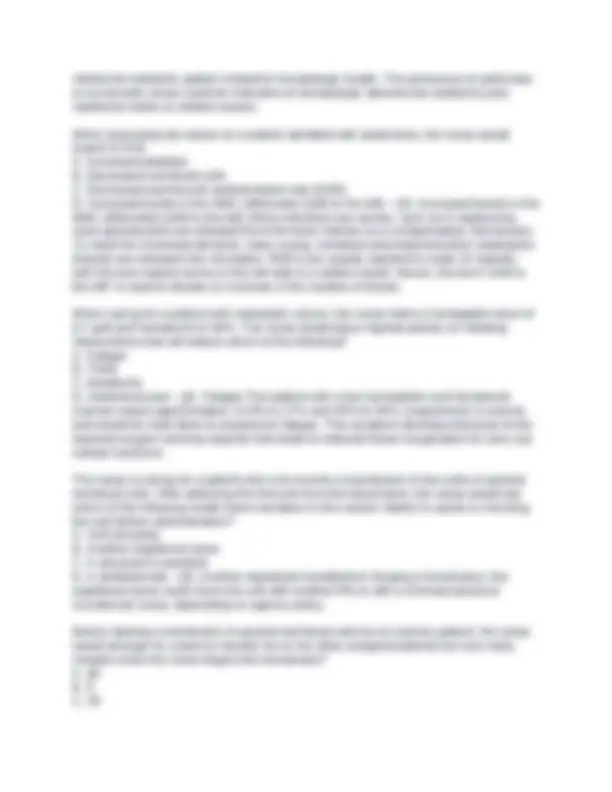
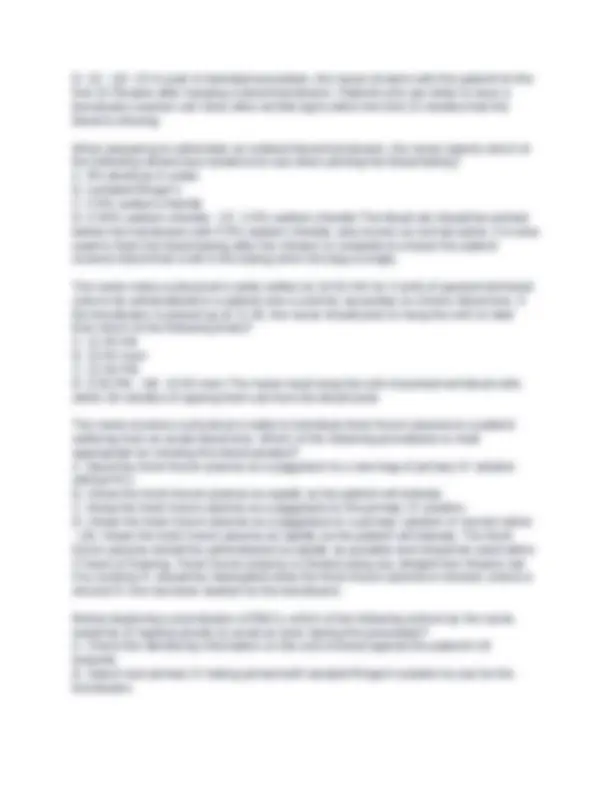
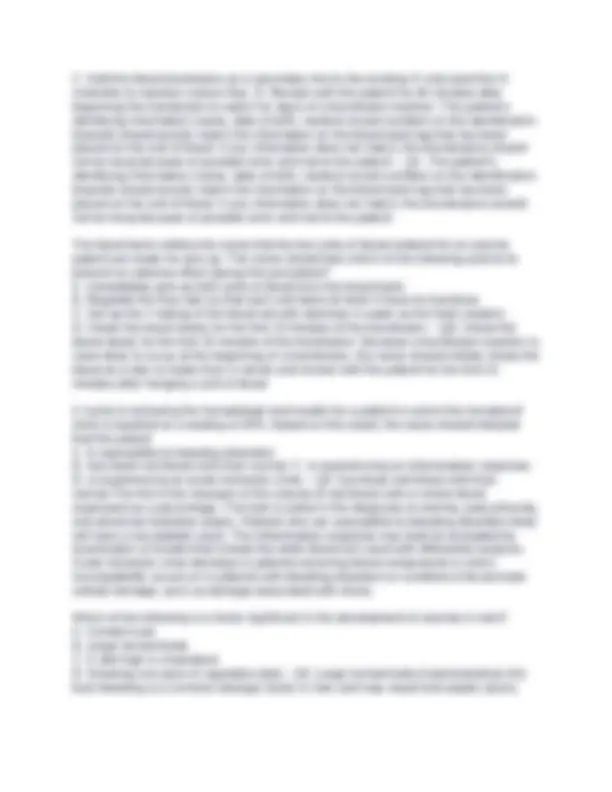
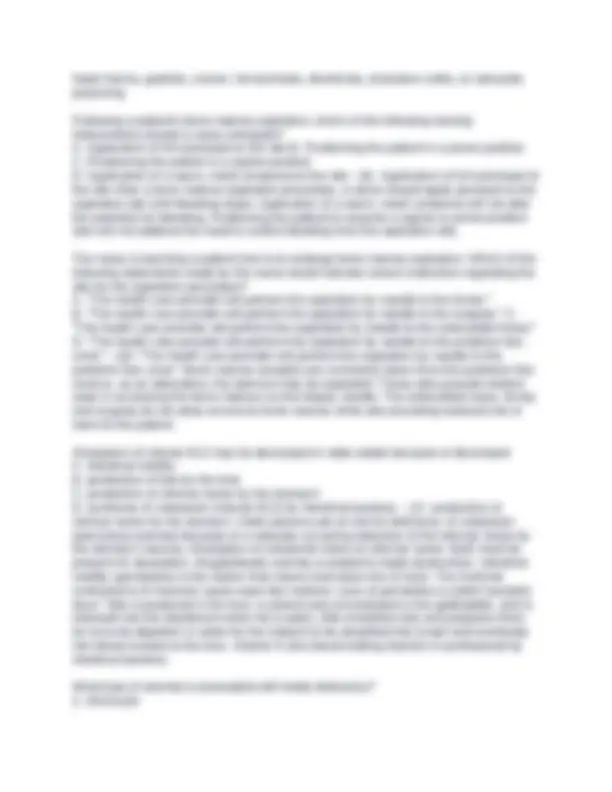
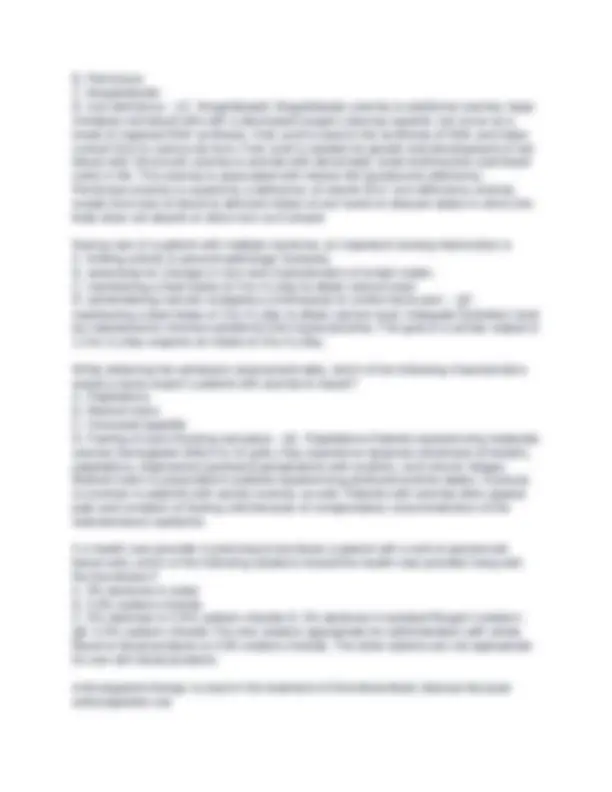
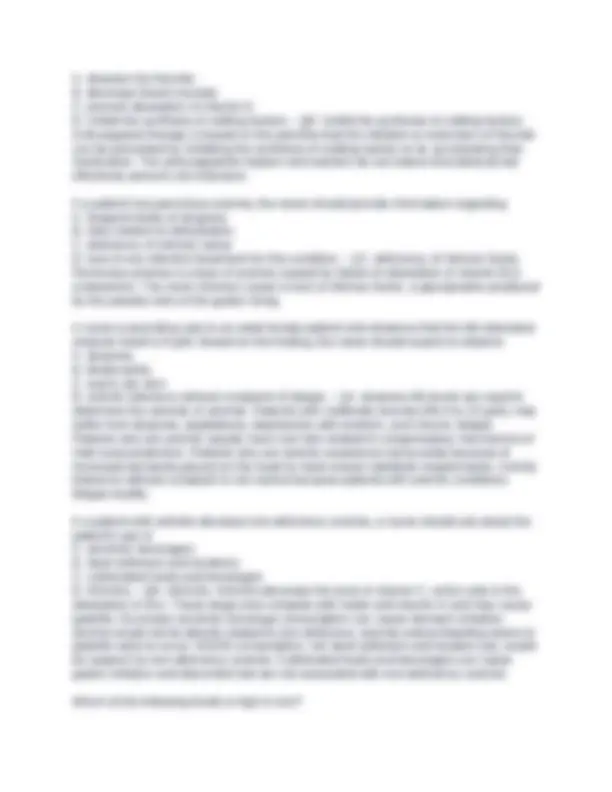
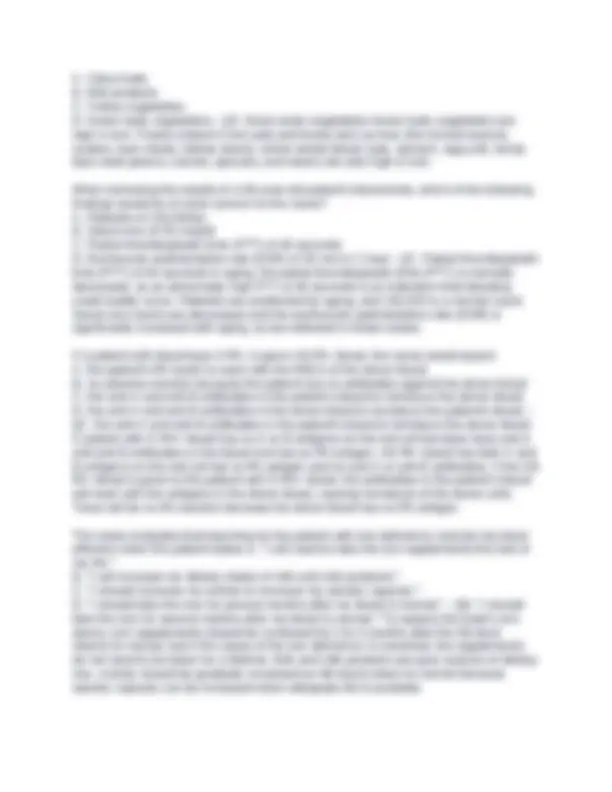
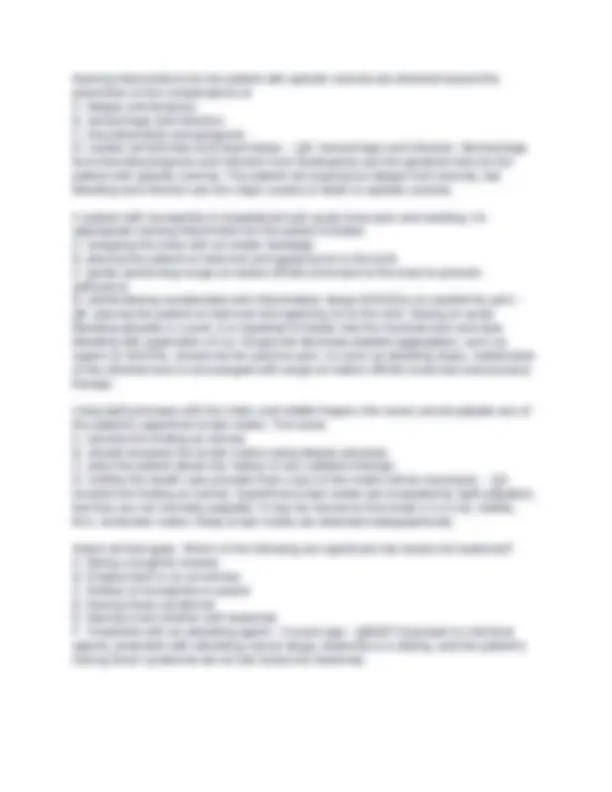
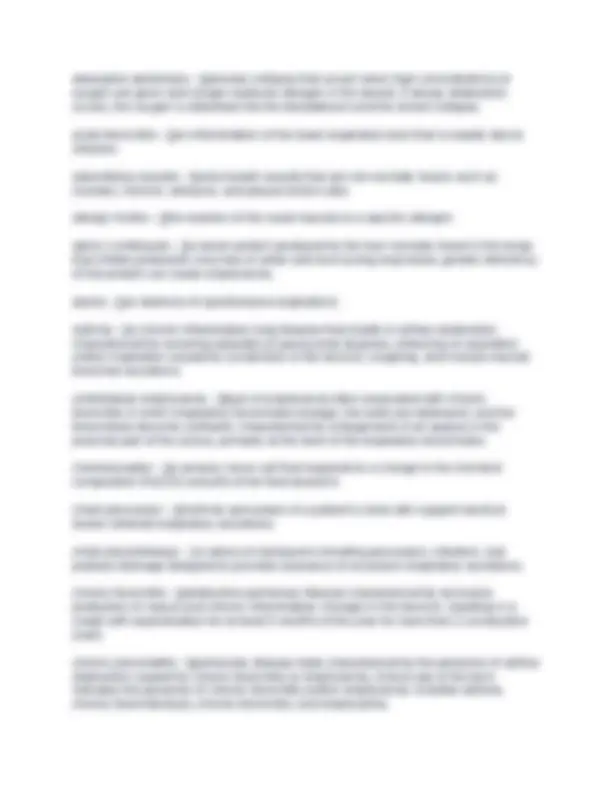
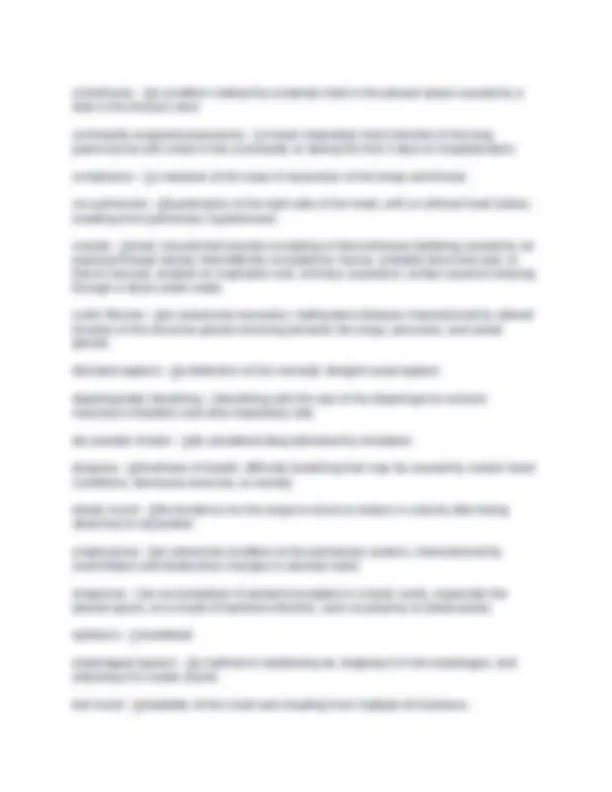
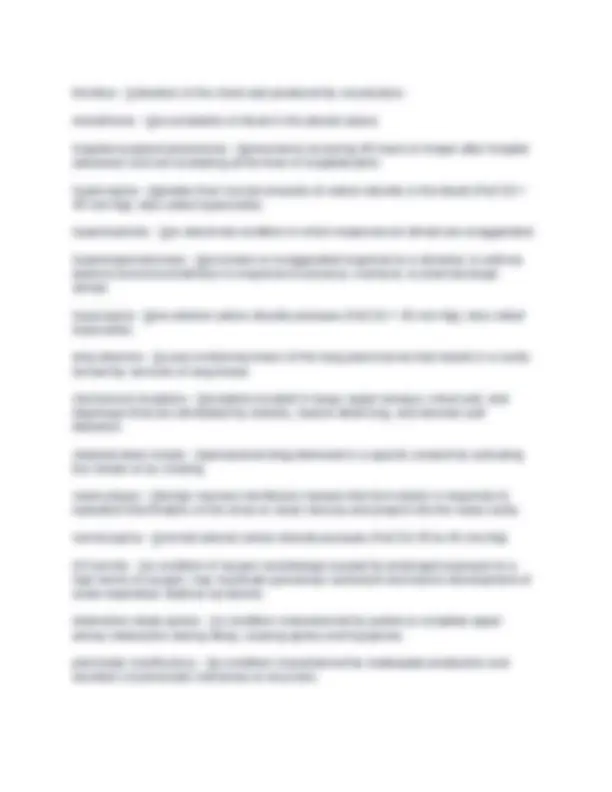
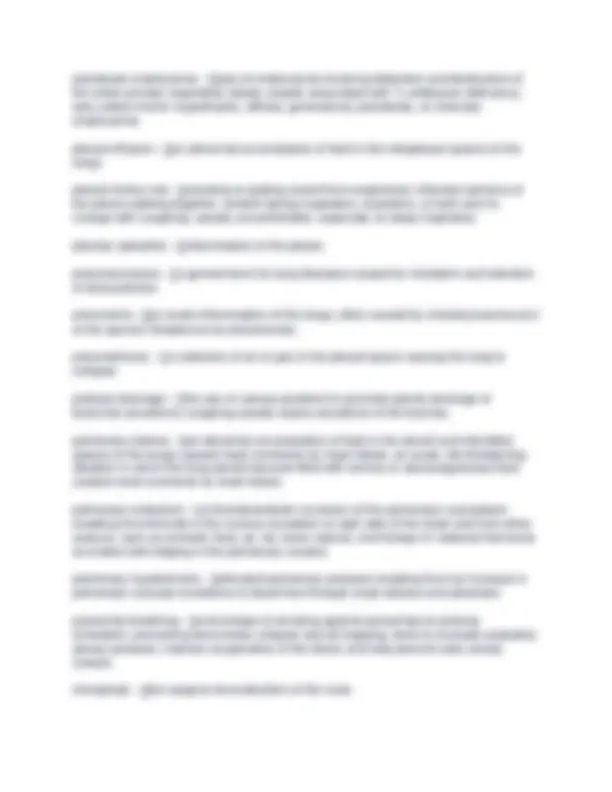
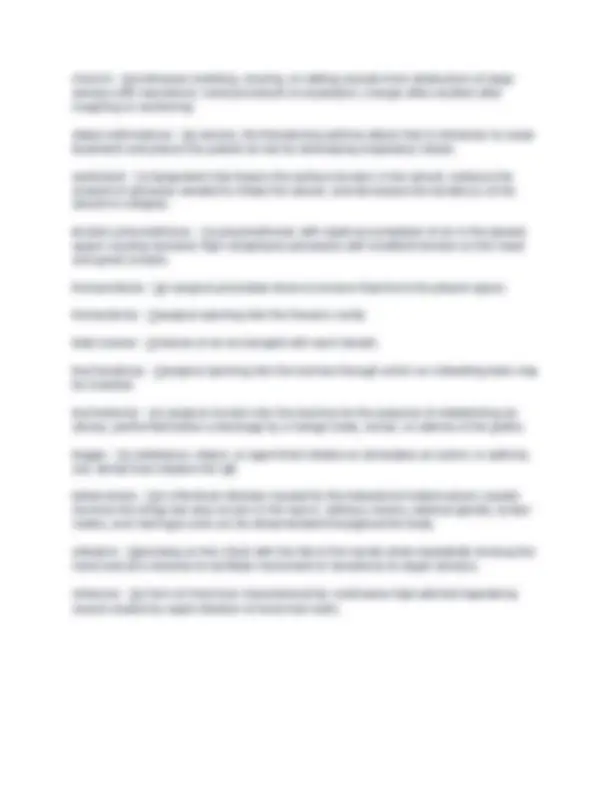


Study with the several resources on Docsity

Earn points by helping other students or get them with a premium plan


Prepare for your exams
Study with the several resources on Docsity

Earn points to download
Earn points by helping other students or get them with a premium plan
Community
Ask the community for help and clear up your study doubts
Discover the best universities in your country according to Docsity users
Free resources
Download our free guides on studying techniques, anxiety management strategies, and thesis advice from Docsity tutors
HESI MED-SURG Practice Questions &Answers Key Terms
Typology: Exams
1 / 59

This page cannot be seen from the preview
Don't miss anything!




















































A female client with a nasogastric tube attached to low suction states that she is nauseated. The nurse assesses that there has been no drainage through the nasogastric tube in the last 2 hours. Which action should the nurse take first? A. Irrigate the nasogastric tube with sterile normal saline. B. Reposition the client on her side. C. Advance the nasogastric tube 5 cm. D. Administer an intravenous antiemetic as prescribed. - ✅B. The priority is to determined if the tube is functioning correctly, which would relieve the client's nausea. The least invasive intervention is to reposition the client (B), should be attempted first, followed by (A & C) if these are unsuccessful then (D). When assigning clients on a medical-surgical floor to a RN and a LPN, it is best for the charge nurse to assign which client to the LPN? A. A child with bacterial meningitis with recent seizures. B. An older adult client with pneumonia and viral meningitis. C. A female client in isolation wiht meningococcal meningitis. D. A male client 1 day post-op after drainage of a brain abscess. - ✅B. Is the most stable. A, C, D have an increased risk for elevated ICP. Which description of symptoms is characteristic of a client with diagnosed with trigeminal neuralgia (tic douloureux)? A. Tinnitus, vertigo, and hearing difficulties. B. Sudden, stabbing, severe pain over the lip and chin. C. Unilateral facial weakness and paralysis. D. Difficulty in talking, chewing, and swallowing. - ✅B. Trigeminal neuralgia is characterized by paroxysms of pain, similar to an electric shock, in the area innervated by one or more branches of the trigeminal nerve. A. Characteristic of Meniere's C. Characteristic of Bell palsey D. Characteristic of disorders of the hypoglossal (12th cranial nerve) Which abnormal lab finding indicates that a client with diabetes needs further evaluation for diabetic nephropathy? A. Hypokalemia B. Microalbuminauria C. Elevated serum lipids D. Ketonuria - ✅B. Microalbuminuria is the earliest sign of nephropathy and indicates the need for follow-up evaluation. Hyperkalemia (A) is associated with end stage renal
disease caused by diabetic nephropathy. (C) may be elevated in end stage renal disease. (D) may signal the onset of DKA. An older male client comes to the geriatric screening clinic complaining of pain in his left calf. The nurse notices a reddened area on the calf of his right leg that is warm to touch and the nurse suspects that the client may have thrombophlebitis. Which addition assessment is most important for the nurse to perform? A. Measure calf circumference. B. Auscultate the client's breath sounds. C. Observe for ecchymosis and petechiae. D. Obtain the client's blood pressure. - ✅B. Since the client may have a pulmonary embolus secondary to the thrombophlebitis. A. Would support the nurses assessment. C. Least helpful since bruising is not associated with thrombophlebitis. D. Less important then auscultation. The nurse know that a client taking diuretics must be assessed for the development of hypokalemia, and that hypokalemia will create changes in the client's normal ECG tracing. Which ECG change would be an expected finding in the client with hypokalemia? A. Tall, spiked T waves B. A prolonged QT interval C. A widening QRS complex D. Presence of a U wave - ✅D. A U wave is a positive deflection following the T wave and is often present with hypokalemia. A, B, C indicate hyperkalemia. An older client is admitted with a diagnosis of bacterial pneumonia. The nurse's assessment of the client will most likely reveal which S/SX? A. Leukocytosis and febrile. B. Polycythemia and crackles. C. Pharyngitis and sputum production. D. Confusion and tachycardia. - ✅D. The onset of pneumonia is the older may be signaled by general deterioration, confusion, increased heart rate or increased respiratory rate. (A, B, C) are often absent in the older with bacterial pneumonia. The nurse observes ventricular fibrillation on telemetry and upon entering the clients bathroom finds the client unconscious on the floor. What intervention should the nurse implement first? A. Administer an antidysrhythmic medication. B. Start cardiopulmonary resuscitation. C. Defibrillate the client at 200 joules.
A. Help the client to dangle his legs. B. Apply compression stockings. C. Assist with passive leg exercises. D. Ambulate three times daily. - ✅A. A client who has arterial PVD may benefit from a dependent position which can be achieved by dangling by improving blood flow and relieving pain. (B) is indicated for venous insufficiency and (C) is indicated for bed rest. (D) is indicated to facilitate collateral circulation and may improve long term complaints of pain. A 58-year-old client, who has no health problems, asks the nurse about taking the pneumococcal vaccine (Pneumovax). Which statement give by the nurse would offer the client accurate information about this vaccine? A. "The vaccine is given annually before the flue season to those over 50 years of age." B. "The immunization is administered once to older adults or persons with a history of chronic illness." C. "The vaccine is for all ages and is given primarily to those person traveling overseas to infected areas." D. "The vaccine will prevent the occurrence of pneumococcal pneumonia for up to 5 years." - ✅B. It is usually recommended that persons over 65 years of age and those with a history of chronic illness should receive the vaccine once in a lifetime. (A) the influenza vaccine is given annually. (C) travel is not the main rationale for the vaccine. (D) The vaccine is usually given once in a lifetime. A client with hypertension has been receiving ramipril (Altace) 5 mg PO daily for 2 weeks and is scheduled to receive a dose at 0900. At 0830 the client's blood pressure is 120/70. Which action should the nurse take? A. Administer the dose as prescribed. B. Hold the dose and contact the healthcare provider. C. Hold the dose and recheck the blood pressure in 1 hour. D. Check the healthcare provider's prescription to clarify the dose. - ✅A. The BP is WNL and indicates that the medication is working. (B & C) would be indicated if the BP was low (systole below 100). (D) is not required because the dose is within manufacture's recommendations. The nurse know that normal lab values expected for an adult may vary in an older client. Which data would the nurse expect to find when reviewing laboratory values of an 80- year-old man who is in good overall health. A. Complet blood count reveals increased WBC and decreased RBC counts. B. Chemistries reveal an increased serum bilirubin with slightly increased liver enzymes. C. Urinalysis reveals slight protein in the urine and bacteriuria with pyuria. D. Serum electrolytes reveal a decreased sodium level with an increased potassium level. - ✅C. In older adults the protein found in urine is slightly risen as a result of kidney changes or subclinical UTIs and the client frequently experiences asymptomatic
bacteriuria and pyuria as a result of incomplete bladder emptying. (A, B, D) are not normal findings. The nurse is completing an admission inter for a client with Parkinson disease. Which question will provide addition information about manifestations the client is likely to experience? A. "Have you ever experienced and paralysis of your arms or legs?" B. " Do you have frequent blackout spells?" C. "Have you ever been 'frozen' in one spot, unable to move?" D. "Do you have headaches, especially ones with throbbing pain?" - ✅C. Parkinson clients frequently experience difficulty in initiating, maintaining, and performing motor activities. They may even experience being rooted, unable to move. (A, B, D) Does not typically occur in Parkinson. During the change of shift report, the charge nurse reviews the infusions being received by the clients on the oncology unit. The client receiving which infusion should be seen first? - ✅C. Has the highest risk for respiratory depression and therefor should be seen first. (A) Risk of hypotension. (B) Lowest risk. (D) Risk of nephrotoxicity and phlebitis. The home health nurse is assessing a male client being treated for Parkinson disease with levodopa-carbidopa (Sinemet). The nurse observes that he does not demonstrate any apparent emotions when speaking and rarely blinks. Which intervention should the nurse implement? A. Perform a complete cranial nerve assessment. B. Instruct the client that he may be experiencing medication toxicity. C. Document the presence of these assessment findings. D. Advise the client to seek immediate medical evaluation. - ✅C. A mask-like expression and infrequent blinking are common clinical features of Parkinsonism. The nurse should document the findings. (A & D) are not necessary. Signs of toxicity (B) are dyskinesia, hallucinations, and psychosis. A client is placed on a mechanical ventilator following a cerebral hemorrhage, and vecuronium bromide (Norcuron) 0.04 mg/kg every 12 hours IV is prescribed. What is the priority nursing diagnosis for this client? A. Impaired communication related to paralysis of skeletal muscles. B. Hight risk or infection related to increased ICP. C. Potential for injury related to impaired lung expansion. D. Social isolation related to inability to communicate. - ✅A. To increase the client's tolerance of the endotracheal intubation and/or mechanical ventilation, a skeletal- muscle relaxant such as vecuronium is usually prescribed. (A) is a serious outcome because the client cannot communicate his/her needs. (D) is not as much of a priority. (B) infection is not related to ICP. (C) is incorrect because the ventilator will ensure that the lungs are expanded.
Seconal 0.1 gram PRN at bedtime is prescribed for rest. The scored tablets are labeled grain 1.5 per tablet. How many tablets should the nurse plan to administer? A. 1/2 tablet B. 1 tablet C. 1 1/2 tablet D. 2 tablets - ✅B. 15 gr = 1 g, 0.1 x 15 = 1.5 grains Which content about self-care should the nurse include in the teaching plan of a client who has genital herpes? (Select all that apply.) A. Encourage annual physical and Pap smear. B. Take antiviral medication as prescribed. C. Use condoms to avoid transmission to others. D. Warm sitz baths may relieve itching. E. Use Nystatin suppositories to control itching. F. Douche with weak vinegar solutions to decrease itching. - ✅A,B,C,D. (E) is specific for Candida infections and (F) is used to treat Trichomonas. A client with chronic asthma is admitted to postanesthesia complaining of pain at level 8 of 10, with a BP of 124/78, pulse of 88 beats/min, and respirations of 20 breaths/min. The postanesthesia recovery prescription is, "Morphine 2 to 4 mg IV push while in recovery for pain level over 5." What intervention should the nurse implement? A. Give the medication as prescribed to decrease the client's pain. B. Call the anesthesia provider for a different medication for pain. C. Use nonpharmacologic techniques before giving the medication. D. Reassess pain level in 30 Minutes and medicate if it remains elevated. - ✅B. Call for a different medication because morphine and meperidine (Demerol) have histamine- releasing narcotics and should be avoided when a client has asthma. (A) puts the client at risk for asthma attack. (C & D) disregard the clients prescription and pain relief. During report, the nurse learns that a client with tumor lysis syndrome is receiving an IV infusion containing insulin. Which assessment should the nurse complete first? A. Review the client's history for diabetes mellitus. B. Observe the extremity distal to the IV site. C. Monitor the client's serum potassium and blood glucose. D. Evaluate the client's oxygen saturation and breath sounds. - ✅C. The client with tumor lysis syndrome may experience hyperkalemia, therefor it is important to monitor serum potassium and blood glucose levels. (A, B, D) are not as priority. During assessment of a client in the intensive care unit, the nurse notes that the client's breath sounds are clear upon auscultation, but jugular vein distention and muffled heart sounds are present. Which intervention should the nurse implement? A. Prepare the client for a pericardial tap.
B. Administer intravenous furosemide (Lasix). C. Assist the client to cough and deep breathe. D. Instruct the client to restrict oral fluid intake. - ✅A. The client is exhibiting symptoms of cardiac tamponade that results in reduced cardiac output. Treatment is pericardial tap. (B) is not a treatment. (C) is not priority. (D) Fluids are frequently increased but this is not as priority as (A). In assessing an older client with dementia for sundowning syndrome, what assessment technique is best for the nurse to use? A. Observe for tiredness at the end of the day. B. Perform a neurologic exam and mental status exam. C. Monitor for medication side effects. D. Assess for decreased gross motor movement. - ✅A. Sundowning syndrome is a pattern of agitated behavior in the evening, believed to be associated with tiredness at the end of the day combined with fewer orienting stimuli, such as activities and interactions. (B, C, & D) with not provide information about this syndrome. Which condition should the nurse anticipate as a potential problem in a female client with a neurogenic bladder? A. Stress incontinence. B. Infection. C. Painless, gross hematuria. D. Peritonitis. - ✅B. Infection is the major complication resulting from stasis of urine and subsequent catheterization. (A) is the involuntary loss of urine through an intact urethra as a result of suddenly increased pressure. (C) is the most common symptom of bladder cancer. (D) is the most common and serious complication of peritoneal dialysis. The nurse is interviewing a client who is taking interferon-alfa-2a (Roferon-A) and ribavirin (Virazole) combination therapy for hepatitis C. The client reports experiencing overwhelming feelings of depression. What action should the nurse implement first? A. Recommend mental health counseling. B. Review the medications actions and interactions. C. Assess for the client's daily activity level. D. Provide information regarding a support group. - ✅B. Alpha-interferon and ribavirin combination therapy can cause severe depression. (A, B, C) may be implemented after physiological aspect of the situation are assessed. The nurse is assessing a 75-year-old male client for symptoms of hyperglycemia. Which symptom of hyperglycemia is an older adult most likely to exhibit? A. Polyuria B. Polydipsia C. Weight loss
B. Hypocalcemia C. Hyponatremia D. Hypokalemia - ✅B. Hypocalcemia develops in CKD due to chronic hyperphosphatemia not (A). (C & D) incorrect you would find hypernatremia and hyperkalemia Debilitating anginal pain can be decreased in some clients by the administration of beta- blocking agents such as nadolol (Corgard). Which client requires the nurse to use extreme caution when administering Corgard? A. A 56-year-old air traffic controller who had bypass surgery 2 years ago. B. A 47-year-old kindergarten teacher diagnosed with asthma 40 years ago C. A 52-year-old unemployed stock broker who refuses treatment for alcoholism D. A 60-year-old retired librarian who takes a diuretic daily for hypertension. - ✅B. asthma must be carefully monitored because beta blockers because it can induce cardiogenic shock and reduce bronchodilation efforts. (A & D) this medication is indicated and (C) it is not contraindicated. A male client who has never smoked but has had COPD for the past 5 years is now being assessed for cancer of the lung. The nurse knows that he is most likely to develop which type of lung cancer? A. Adenocarcinoma B. Oat-cell carcinoma C. Malignant melanoma D. Squamous-cell carcinoma - ✅A. is the only lung cancer not related to cigarette smoking related to lung scarring and fibrosis from preexisting pulmonary diseases such as TB and COPD. (B& D) are related to smoking. (C) is a skin cancer The nurse is caring for a client with a chest tube to water seal drainage that was inserted 10 days ago because of a ruptured bullae and pneumothorax. Which finding should the nurse report to the healthcare provider before the chest tube is removed? A. Tidal of water in the water seal chamber B. Bilateral muffled breath sounds at bases C. Temperature of 101 degrees F D. Absence of chest tube drainage for 2 days. - ✅A. Tidal in the water seal chamber should be reported to the HPC to show that the chest tube is working properly. (B) may indicate hypoventilation from the chest tube and usually improves when the tube is removed. (C) indicates infection (D) is an expected finding. A central venous catheter has been inserted via a jugular vein and a radiography has confirmed placement of the catheter. A prescription has been received for stat medication but IV fluids have not yet been started. What action should the nurse take prior to administering the prescribed medication? A. Assess for signs of jugular vein distention. B. Obtain the needed intravenous solution.
C. Administer a bolus of normal saline solution. D. Flush the line with heparinized saline. - ✅C. A medication can be administered central line without IV fluids, flush with normal saline to remove heparin that may counteract with the medication. (B) is used following the medication and a second saline bolus. (A) will not impact the the med administration and is not a priority. (B) Administration of the stat medication is more of a priority than (B). The nurse assesses a postoperative client. Oxygen is being administered at 2 L/min and a saline lock is in place. Assessment shows cool, pale, moist skin. The client is very restless and has scant urine in the urinary drainage bag. What intervention should the nurse implement first. A. Measure urine specific gravity. B. Obtain IV fluids for infusion protocol. C. Prepare for insertion of a central venous catheter. D. Auscultate the client's breath sounds. - ✅B. The client is at risk for hypovolemic shock and is exhibiting early signs. Start IV to restore tissue perfusion. (A, C, D) are all important but less of a priority. A client diagnosed with angina pectoris complains of chest pain while ambulating in the hallway. Which action should the nurse implement first? A. Support the client to a sitting position. B. Ask the client to walk slowly back to the room. C. Administer a sublingual nitroglycerin tablet. D. Provide oxygen via nasal cannula. - ✅A. Assist in safely repositioning and then administer (C & D). Then the client can be escorted back to the room via wheelchair or stretcher (B). A 55-year-old male client is admitted to the coronary care unit having suffered an acute myocardial infarction (MI). Within 24 hours of the occurrence, the nurse can expect to find which systemic sign? A. Elevated serum amylase level B. Elevated CM-MB level C. Prolonged prothrombin time (PT) D. Elevated serum BUN and creatinine - ✅B. Tissue damage in the myocardium causes the release of cardiac enzymes into the blood system. An elevated CM-MB is a recognized indicator of an MI. It peaks 12 - 24 hours and returns to normal within 48 - 78 hours. (A) would indicate pancreatitis or a gastric disorder. (D) Although an elevated BUN might be related to an acute MI it is usually associated with dehydration, high protein intake or gastrointestinal bleeding and creatine levels indicate renal damage. (C) Indicates effective anticoagulation therapy. The nurse is assessing a client who presents with jaundice. Which assessment finding is the most significant indication that further follow up is needed?
of LOC. (B) is important but not the best indicator of LOC. (C) can be assessed after LOC has been established by assessing eye opening. A 43-year-old homeless, malnourished female client with a history of alcoholism is transferred to the ICU. She is placed on telemetry, and the rhythm strip shown is obtained. The nurse palpates a heart rate of 160 beats/min, and the client's blood pressure is 90/54. Based on these finding, which IV medication should the nurse administer? A. Amiodarone (Cordarone) B. Magnesium sulfate C. Lidocaine (Xylocaine) D. Procainamide (Pronestyl) - ✅B. Because the client has chronic alcoholism, she is likely to have hypomagnesium. (B) is the recommended drug for torsades de pointes (AHA, 2005), which is a form of polymorphic ventricular tachycardia (VT), usually associated with a prolonged QT interval that occurs with hypomagnesemia. (A and D) increase the QT interval, which can cause the torsades to worsen. (C) is the antiarrhythmic of choice in most cases of drug-induced monomorphic VT, not torsades. The nurse is caring for a critically ill client with cirrhosis of the liver who has a nasogastric tube draining bright red blood. The nurse notes that the client's serum hemoglobin and hematocrit are decreased. What additional change in lab data should the nurse expect? A. Increased serum albumin B. Decreased serum creatinine C. Decreased serum ammonia D. Increased liver function tests - ✅C. The breakdown of glutamine in the intestine and the increased activity of colonic bacteria from the digestion of proteins increases the ammonia levels in the clients with advanced liver disease, so removal of blood, a protein source, from the intestines results in reduced ammonia. (A, B, D) will not be significantly impacted by the removal of blood. A family member was taught to suction a client's tracheostomy prior to the client's discharge from the hospital. Which observation by the nurse indicates that the family member is capable of correctly performing the suctioning technique? A. Turns on the continuous wall suction to -190 mm Hg B. Inserts the catheter until resistance or coughing occurs C. Withdraws the catheter while maintaining suctioning D. Re-clears the tracheostomy after suctioning the mouth - ✅B. indicates correct technique for performing suctioning. Suction pressure should be between -80 and - (A). The catheter should be withdrawn 1-2 cm at a time with intermittent suction (C). (D) introduces pathogens.
The nurse is planning the care for a client who is admitted with the syndrome of inappropriate antidiuretic hormone secretion (SIADH). Which interventions should the nurse include in this client's plan of care? (Select all that apply.) A. Salt-free diet B. Quiet environment C. Deep tendon reflex assessments D. Neurologic checks E. Daily weights F. Unrestricted intake of free water - ✅B, C, D, E. SIADH results in water retention and dilutional hyponatremia, which causes neurologic change when serum sodium levels are less than 115 mEq/L. The nurse should maintain a quiet environment (B) to prevent overstimulation that can lead to periods of disorientation, assess deep tendon reflexes (C) and neurologic checks (D) to monitor for neurologic deterioration. Daily weights (E) should be monitored to assess for fluid overload: 1 kg weight gain equals 1 L of fluid retention, which further dilutes serum sodium levels. (A and F) contribute to dilutional hyponatremia. levodopa (Sinemet) - ✅Parkinsons Disease lessen tremors increases amount of levodopa to CNS (dopamine to the brain) s/s toxicity=dyskinesia, hallucinations, psychosis Aldosteronism - ✅lab =decreased serum level of potassium hypokalemia hypertension seconel - ✅sleep aide 15g=1g Laryngectomy - ✅cuff should be inflated only prior to feeding tumor lysis syndrome - ✅hyperkalemia may occur =requires insulin to reduce serum potassium = monitor serium potassium and blood glucose levels older adults - ✅protein found in urine slightly rises as a result of kidney change or UTI w/asymptomatic bacteriuria and pyuria as a result of incomplete bladder emptying chest tube - ✅decreased drainage =assess for kinks or dependant loops -do not clamp off angina pectoris - ✅when walking=1.assist to seated position; 2. sublingual nitroglycerin; 3.oxygen 4. wheelchair to room
lactulose (Cephulac) - ✅reduce blood ammonia by excreation of ammonia by stools 2 -3 soft stools per day IV's infusions potential problems - ✅morphine, continous epidural = respiratory depression magnesium continous infusion = hypotension vancomycin intermittent infusion = nephrotoxicity & phlebitits pancreatitis - ✅serium amylase & lipase 2 to 5 times higher than normal hypercalcemia 40 ~ 75% = positive trousseau sign = carpal spasm severe boring pain hypercalcemia - ✅positive trousseau sign = carpal spasm neurogenic bladder - ✅infection - from stasis of urine and subsuquent catheterization CKD chronic kidney disease - ✅prior to hemodialysis lab= hypocalcemia due to hyperphosphatemia, hyperkalemic & hypernatremic gangrene - ✅necrosis/tissue death priority prevent infection olpthalmoscopic exam - ✅from a distance of 8-12 inches and slightly to the side, shine the light in the clients pupil; client should focus on distant object to promote dialation, olpthalmoscopic set at 0 lens to begin, should be held in front of the examiners left eye when examining clients right eye and kept within 1 inch of clients eye for optimum visualation hypokalemia - ✅patients on diuretics will change patients normal ECG = U wave is positive deflection following the T wave often present in hypokalemia ECG - ✅U wave is positive deflectionfollowing the T wave often present in hypokalemia tall spiked T wave, prolonged QT intervial, widening QRS complex are all signs of hyperkalemia Hyperkalemia - ✅ECG=tall spiked T wave, prolonged QT intervial, widening QRS complex are all signs of hyperkalemia; tumor lysis syndrome ACE inhibitor - ✅cough os a common side effect hypertension do not stop abruptly (rebound hypertension may occur)
permanent pacemaker - ✅changes in pulse rate in rythem may indicate pacer failure dizziness may be due to decreased heart rate leading to decreased cardiac output; should carry a card in wallet with type and serial number of pacemaker; report redness and tenderness - s/s infection sundowning - ✅agitated behavior in the evening observe for tirdness at the end of the day Pap smear - ✅should be continued through menapause to test for vaginal and cervical cancer NG Tube - ✅no drainage in 2 hours client nausated = reposition client on side hypomagnesemia - ✅chronic alcholic ie HR 160 BP 90/54 give IV magnesium sulphate prolonged QT intervial Magnesium Sulphate - ✅hypomagnesemia reccomended for torsadesde pointes a form of polymorphic ventrical tackycardia associated with a prolonged QT intervial that occurs with hypomagnesemia older adults - ✅stooped posture results in upper torso becomming center of gravity Cushing Syndrome - ✅results from hypersecreation glucocorticoids in the adrenal cortex often develope diabetes mellitus - monitor serum glucose levels generialized edema low calorie, low carbohydrate, low sodium diet jaundice - ✅serium amylase & lipase 2 times higher than normal indicate pancreatic injury frothy tea colored urine clay colored stools complaints of puritis PVD peripheral vascular disease - ✅help client dangle legs digitalis (Lanoxin) digoxin - ✅cardiac glycoside can build up toxic levels s/s anexoria, nausea, vomiting, diarrhea, headache, fatigue Hepatitis B - ✅health care providers should have Hep B vaccine; transmitted by fecal/oral contamination nadolol (Corgard) - ✅beta blocker
-scope - ✅Instrument to visually examine. Cystocele - ✅Hernia of the urinary bladder. Malignant myeloma - ✅Tumor of bone marrow. Myelogram - ✅X-ray record of the spinal cord. -cocci - ✅Berry shaped bacteria. -graph - ✅Instrument to record. -oid - ✅Resembling Leukocyte - ✅Eosinophil is a (an) Laryngectomy - ✅Removal of the voice box. Angioplasty - ✅Surgical repair of blood vessel. Lymphocyte - ✅A blood cell that produces antibodies. Hypertrophy - ✅Excessive devolopment. -therapy - ✅Treatment. -stomy - ✅Surgical creation of a permanent opening to the outside of the body. Catabolism - ✅The process by which food is burned to realease energy. Endoplasmic Reticulum - ✅Part of the cell where formation of proteins occurs. Metabolism - ✅Sum of the chemical processes in a cell. Karyotype - ✅Picture of nuclear structures arranged in numerical order. Mitochondria - ✅Part of a cell where catabolism primarily occurs. Cell Membrane - ✅Allows materials to pass into and out of the cell. DNA - ✅Genes are composed of? Diaphragm - ✅Muscular wall separating the abdominal and thoracic cavities. Mediastinum - ✅The space in the chest between the lungs.
Adipose - ✅Pertaining to fat. Pharynx - ✅Throat. Sarcoma - ✅Malignant tumor of flesh tissue. Craniotomy - ✅Incision of the skull. Histologist - ✅Person who studies tissues. Skin cell - ✅An epithelial cell is a (an) Pleural Cavity - ✅Space between the membranes around the lungs. Viscera - ✅Internal organs. Larynx - ✅Structure in the trachea. Coccyx - ✅Tailbone. Supine - ✅Lying on the back. Hypochondriac regions - ✅The upper lateral regions of the abdomen, beneath the ribs. Liver - ✅RUQ contain the _______. Sagittal - ✅A plane that divides the body into right and left portions. Disc - ✅A piece of cartilage between backbones. The nurse assesses a patient with shortness of breath for evidence of long-standing hypoxemia by inspecting: A. Chest excursion B. Spinal curvatures C. The respiratory pattern D. The fingernail and its base - ✅D. The fingernail and its base Clubbing, a sign of long- standing hypoxemia, is evidenced by an increase in the angle between the base of the nail and the fingernail to 180 degrees or more, usually accompanied by an increase in the depth, bulk, and sponginess of the end of the finger. The nurse is caring for a patient with COPD and pneumonia who has an order for arterial blood gases to be drawn. Which of the following is the minimum length of time the nurse should plan to hold pressure on the puncture site? A. 2 minutes B. 5 minutes C. 10 minutes